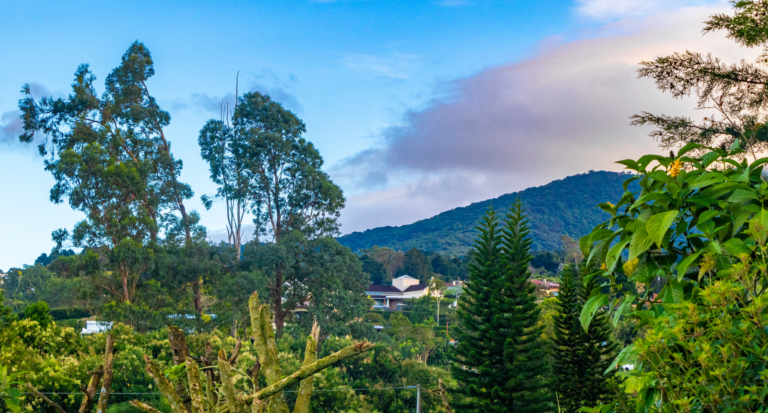Costa Rica Dry Season: What's Covered
Costa Rica’s dry season (December-April) delivers consistent sunshine for Manuel Antonio, Arenal, and Tamarindo. Wildlife congregates around water sources, making spotting easier, while Guanacaste turns golden brown. Expect 20-40% accommodation increases and crowds. Book cars and lodging 3-6 months ahead—4x4s sell out completely.
Quick Facts:
- Regional weather varies—Caribbean wetter, Pacific driest
- Visit attractions by 7 AM before the tour buses at Manuel Antonio and Arenal
- Standard vehicles work most routes; a 4×4 is needed for Monteverde year-round
- Early December/late April offer dry weather with lower shoulder prices
- Fly SJO for central destinations or LIR for Guanacaste
Crowd-Free Alternatives:
- Rincón de la Vieja – Volcanic features, fewer crowds than Arenal
- Marino Ballena – Whale watching without Manuel Antonio masses
- Sámara/Nosara – Authentic beach towns versus packed Tamarindo
Use domestic flights to bypass holiday traffic. Plan La Fortuna hot springs for evenings.
If you need any help with a Costa Rica car rental, contact us now!
Planning a Costa Rica trip between December and April? You’re picking the season with the most reliable sunshine and perfect conditions for pretty much everything. But here’s what nobody tells you – this popularity creates its own set of challenges that can catch you off guard if you’re not prepared.
Whether you’re dreaming of spotting sloths in Manuel Antonio, soaking in Arenal’s hot springs, or catching waves in Tamarindo, let’s talk about how to make the most of Costa Rica’s dry season while dodging the crowds and high prices that come with it.
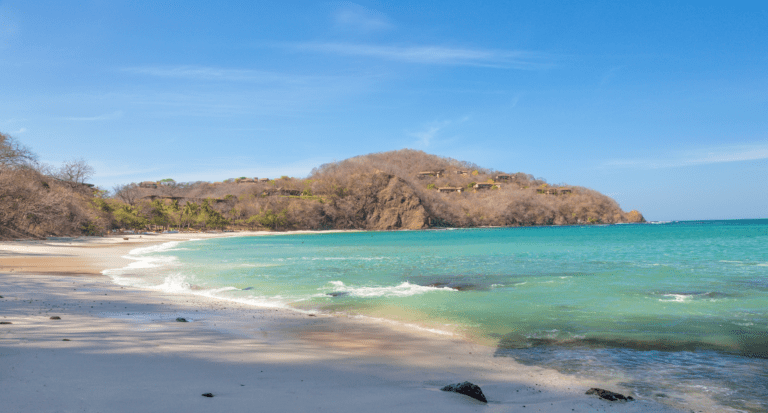
Why Does Everyone Rave About Dry Season in Costa Rica?
Costa Rica’s dry season (December-April) transforms the country in ways that create travel opportunities you won’t find any other time of year.
You get consistently sunny days with minimal rainfall – perfect for beach time, hiking, and wildlife viewing. Mornings start crystal clear, and even if afternoon clouds gather (especially in mountain areas), actual rain is rare and brief.
The Pacific coast and central regions enjoy the most reliable dry weather, while the Caribbean side maintains its own patterns (more on regional differences below).
What Happens to Wildlife During These Months?
Wildlife viewing hits its peak. Animals congregate around remaining water sources, making them easier to spot. Monkey troops become more visible as they move between fruit trees, and sloths often bask in sunny spots to warm up in morning hours.
Here’s something interesting – the landscape completely transforms. The lush green hills of Guanacaste turn golden brown, creating a savanna-like environment that feels totally different from the green season. Deciduous trees drop their leaves, opening up canopies and improving visibility for wildlife spotting.
How Does Weather Actually Vary Across Different Regions?
Costa Rica’s microclimates mean “dry season” looks different depending on where you are. Here’s what to actually expect:
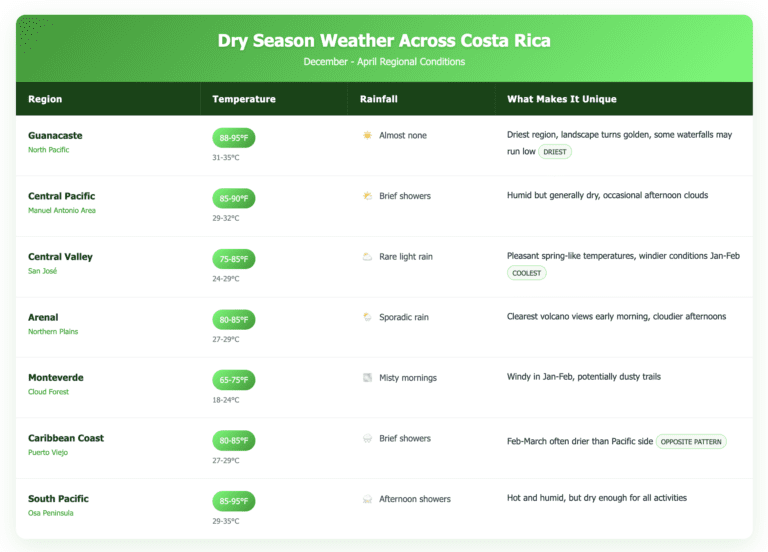
This highlights something important: if you’re experiencing crowded conditions on the Pacific side, consider the Caribbean coast. It often enjoys excellent weather in February and March yet sees way fewer visitors.
How Do You Handle the Crowds and High Prices?
Let’s address the reality – crowds, prices, and availability. Here’s how to handle each challenge:
Where Are the Worst Crowds and How Can You Avoid Them?
The crowds at places like Manuel Antonio National Park or Arenal Hot Springs aren’t your imagination. Visitor numbers can triple during peak weeks.
What works: Visit major attractions on weekdays and very early in the morning. At Manuel Antonio, arrive at the park entrance by 7:00 AM (before tour buses), and you’ll have beaches nearly to yourself until around 10:00 AM.
For Arenal’s hot springs, consider less-famous options like Los Lagos or Paradise Hot Springs rather than always-crowded Tabacón or Baldi. You’ll get the same mineralized water experience with far fewer people.
What Should You Expect to Pay During Peak Season?
Expect 20-40% price increases on accommodations during peak season, with the highest premiums during holiday weeks (Christmas/New Year’s and Easter).
What works: Book accommodations at least 3-4 months in advance. If you’re traveling during holiday weeks, honestly, look 6+ months ahead. For non-holiday weeks, consider “shoulder weeks” of early December or late April – you still get dry weather but with lower rates.

What Gets Booked Up First?
Nothing’s worse than planning a perfect itinerary only to find everything’s booked.
Priority booking list:
- Rental cars (especially 4x4s, which sell out completely)
- Monteverde and Manuel Antonio accommodations
- Popular guided tours like night hikes and sloth spotting
- Rafting trips on the Pacuare River
For rental cars specifically, book directly with a local company as soon as your flights are confirmed. During peak season, international chains often oversell their inventory, leaving travelers stranded despite having “confirmed” reservations.
Which Routes Work Best for Dry Season Road Trips?
One huge advantage of visiting during the dry season? Improved road conditions make this the ideal time for a Costa Rican road trip adventure.
Do You Really Need a 4×4 During Dry Season?
During dry season, most destinations become accessible with standard vehicles, though certain areas still require 4x4s regardless of season:
Routes perfect for standard vehicles (dry season only):
- San José to Manuel Antonio
- Guanacaste beach-hopping
- Central Valley excursions
- San José to La Fortuna/Arenal
Routes still requiring 4x4s even in dry season:
- Monteverde access roads
- Santa Teresa and southern Nicoya Peninsula
- Drake Bay access
- Rincón de la Vieja interior roads
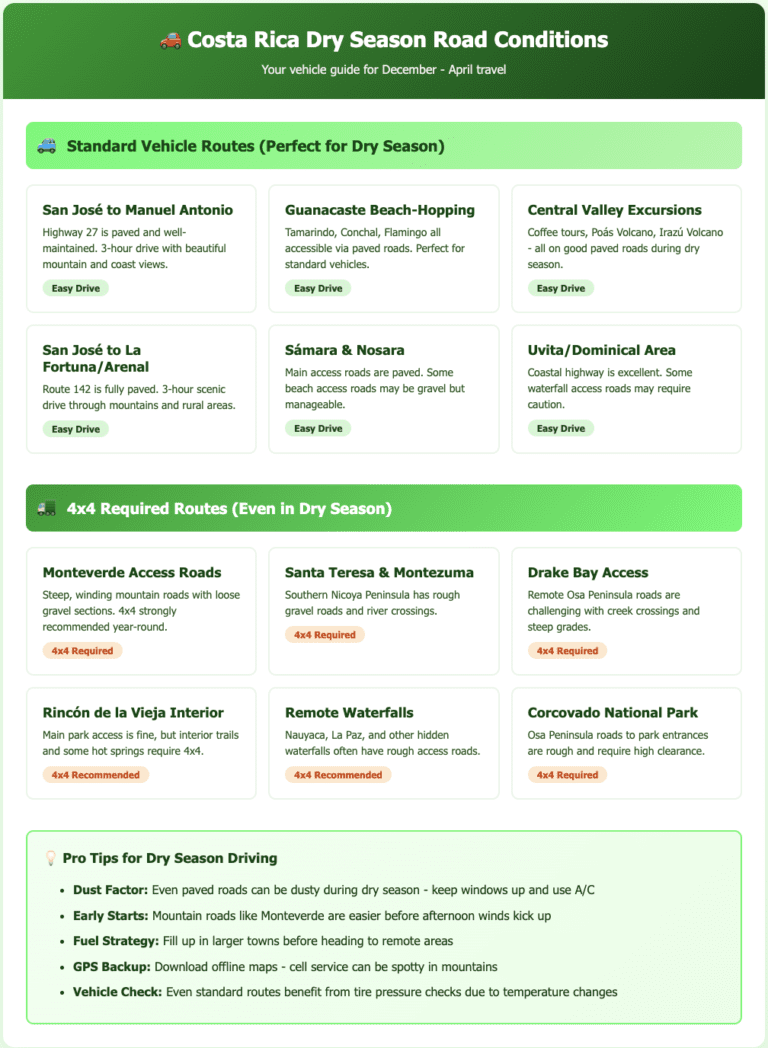
When’s the Worst Time to Drive Between Destinations?
Highway 27 from San José to the Central Pacific and Route 1 to Guanacaste can become seriously congested during weekends and holidays.
Traffic timing tips: If traveling between regions on weekends, leave either very early (before 7:00 AM) or after lunch (2:00 PM) to avoid peak traffic. For holiday weeks, consider using domestic flights for longer distances to bypass traffic altogether.
When picking up your rental car, ask about real-time traffic apps that work well in Costa Rica. Waze is particularly effective here, with locals actively reporting conditions.
When Should You Book Everything? A Practical Timeline
Planning a peak season visit requires more advance preparation. Here’s a timeline that actually works:
What Needs Booking 6+ Months Out?
- Book flights (especially for Christmas/New Year’s or Easter weeks)
- Reserve accommodations for Monteverde, Manuel Antonio and beach destinations
- Secure rental car reservations for specialty vehicles (4x4s, large SUVs)
What Can Wait Until 3-4 Months Before?
- Book remaining accommodations
- Reserve standard rental vehicles
- Secure popular tours and activities (catamaran cruises, guided national park tours)
- Make restaurant reservations for high-end dining
What’s Fine to Book 1-2 Months Ahead?
- Book airport transfers if not renting a car
- Arrange domestic flights for longer distances
- Reserve remaining activities and tours
- Confirm all reservations made earlier
This timeline might seem overly cautious, but peak season availability issues are real – especially for rental cars and popular accommodations.
What Should You Actually Pack for Dry Season?
Packing for dry season means preparing for intense sunshine and occasional dusty conditions, while still having versatility for microclimates:
Often-forgotten essentials:
- High SPF sunscreen (the sun is much more intense than most visitors expect)
- Insulated water bottle (stays cool in hot conditions)
- Light, breathable long sleeves (better than constantly reapplying sunscreen)
- Bandana or buff (multi-purpose for sun protection, dust on gravel roads)
- Electrolyte packets (dehydration happens quickly in Guanacaste heat)
Remember that although it’s “dry season,” you’ll still want a light rain jacket for mountain areas like Monteverde and Arenal, where brief showers remain possible.
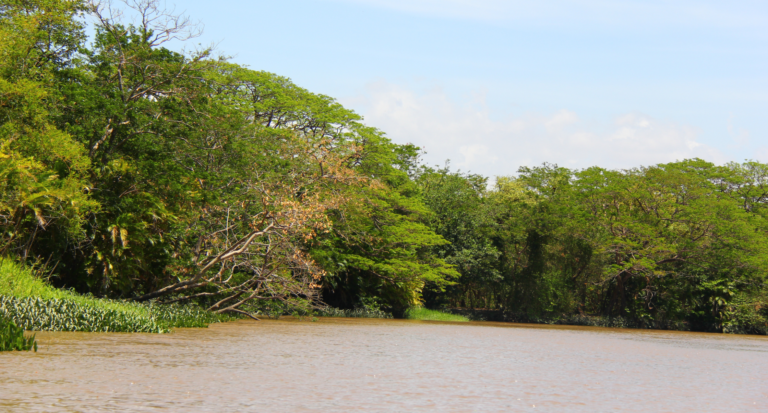
Which Itinerary Style Fits Your Travel Goals?
Before diving into specific routes, let’s talk about some game-changing alternatives to Costa Rica’s most famous destinations. Having your own rental car during the dry season opens up incredible possibilities to experience the same natural wonders with far fewer crowds.
Looking for Beaches Without the Crowds?
Instead of Manuel Antonio, try Marino Ballena National Park
This coastal park in the South Pacific features the famous “whale’s tail” sandbar formation and offers whale watching from December through April. You’ll find similarly beautiful beaches with a fraction of the visitors, plus the unique experience of walking out on a natural formation that literally looks like a whale’s tail at low tide.
Instead of Tamarindo, try Sámara or Nosara
These Nicoya Peninsula beach towns offer great surfing, more authentic vibes, and significantly fewer people. Sámara’s gentle bay makes it perfect for families and beginning surfers, while Nosara has evolved into a yoga and wellness destination with world-class waves.
Want Volcanic Adventures Without Tour Buses?
Instead of La Fortuna/Arenal, try Rincón de la Vieja
This active volcano in Guanacaste offers similar hiking, hot springs, and adventure activities, but with dramatically fewer visitors. During the dry season, the volcanic features like mud pots and fumaroles are more active and impressive.
Now, here are four different 7-day itineraries that work brilliantly during dry season:
Option 1: First-Timer’s Classic Route
This hits the must-see spots that made Costa Rica famous. Yes, you’ll encounter crowds, but you’ll understand why millions choose these destinations.
Day 1: Arrival & Alajuela
- Land at SJO Airport
- Pick up rental car from Vamos Rent-A-Car (airport office makes this seamless)
- Stay in Alajuela rather than attempting to drive far after arrival
- Visit La Garita botanical gardens – beautiful and never crowded
Days 2-3: Arenal/La Fortuna
- Drive to La Fortuna (3 hours from Alajuela)
- Book an early morning hanging bridges tour (7:00 AM start)
- Visit La Fortuna Waterfall during midday when tour groups are at lunch
- Enjoy Ecotermales hot springs in evening (they limit capacity)
Days 4-5: Monteverde
- Drive from Arenal to Monteverde (3 hours with stunning lake views)
- Book 6:30 AM guided hike in cloud forest reserve
- Visit less-known Santa Elena Reserve instead of main Monteverde Reserve
- Enjoy night tours which naturally limit crowd sizes
Days 6-7: Manuel Antonio
- Drive from Monteverde to Manuel Antonio (3.5 hours)
- Visit Manuel Antonio National Park at opening (7:00 AM)
- Explore quieter beaches north of Manuel Antonio in afternoons
- Book sunset sailing tour (more intimate than crowded daytime options)
Option 2: Skip the Crowds, Keep the Magic
Want incredible experiences with half the crowds? This route delivers authentic Costa Rica without the tour bus parade.
Day 1: Arrival & Alajuela
- Same smart airport strategy
Days 2-3: Rincón de la Vieja
- Drive to Rincón de la Vieja area (2.5 hours from Alajuela)
- Hike to active volcanic features early morning
- Experience natural hot springs at Rio Negro or Vandara
- Take canopy zipline tour through dry tropical forest
Days 4-5: Monteverde
- Drive from Rincón to Monteverde (2.5 hours)
- Same cloud forest strategy – early morning is key
- Consider staying extra night since you skipped crowds at first stop
Days 6-7: Marino Ballena National Park
- Drive from Monteverde to Uvita (4 hours but incredibly scenic)
- Walk out on famous “whale’s tail” sandbar at low tide
- Book whale watching tour (December-April is humpback season)
- Visit Nauyaca Waterfalls for swimming in natural pools
Option 3: Beach Lovers’ Paradise
Perfect for families or anyone wanting more beach time with genuine local culture.
Day 1: Arrival & Transit
- Land at LIR Airport instead of SJO (if flight options work)
- Pick up rental car and drive straight to coast (1 hour)
- Alternative: Fly into SJO, stay Alajuela, drive to coast next day
Days 2-3: Sámara
- Base yourself in this calm bay town
- Learn to surf in gentle waves
- Take boat trip to Chora Island for snorkeling
- Experience authentic Costa Rican beach town life
Days 4-5: Nosara
- Drive 45 minutes south
- Morning surf lessons at Guiones Beach
- Visit Ostional Wildlife Refuge for turtle nesting
- Explore Nosara Biological Reserve
Days 6-7: Mountain Escape
- Drive inland to either Monteverde or Arenal (3-4 hours)
- If Monteverde: Focus on bird watching and night tours
- If Arenal: Prioritize volcano views and hot springs
Option 4: Best of Both Worlds
Can’t decide? This hybrid gives you one major highlight plus two lesser-known gems.
Day 1: Arrival & Alajuela
Days 2-3: Arenal/La Fortuna
- Include this because volcano views during dry season are genuinely spectacular
- Follow crowd-avoidance strategies from Option 1
Days 4-5: Rincón de la Vieja
- Experience volcanic activity without crowds
- See how different Costa Rica’s volcanic regions can be
Days 6-7: Your Choice
- Sámara for relaxed beach time
- Marino Ballena for whale watching
- San José area for coffee plantation tours
Which Vehicle Do These Routes Actually Need?
All these routes work well with a standard SUV during dry season, though Monteverde and some beach access roads benefit from 4WD.
Realistic driving times: Add 30-45 minutes to any estimate for stops, fuel, and wildlife sightings that make you pull over.
Cost differences: Alternative destinations often cost 20-30% less than popular spots, especially for accommodations and tours.
The key insight? During the dry season, every route works beautifully. Your choice comes down to whether you want to see what made Costa Rica famous or discover the places tourists haven’t found yet.
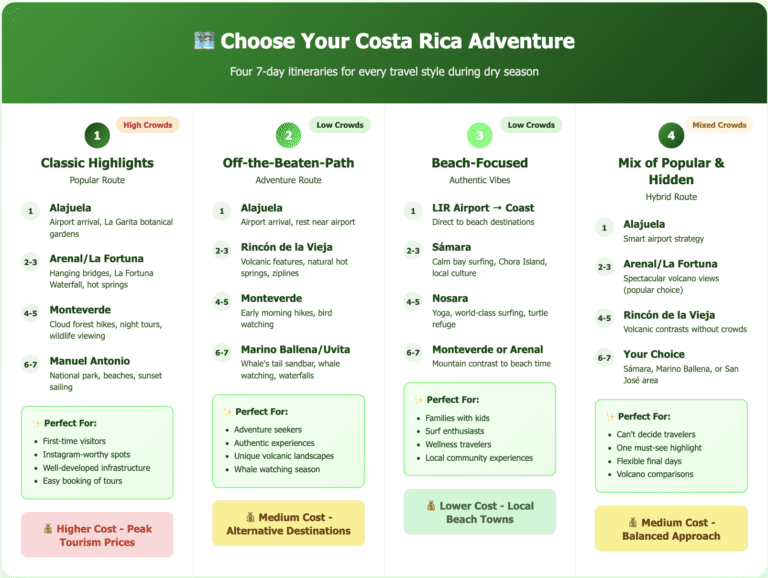
What If It Actually Rains During Dry Season?
While dry season is reliably sunny, Costa Rica’s microclimate diversity means you should always have backup plans:
- Download offline maps – Cell service can be spotty in mountain regions
- Book accommodations with covered outdoor spaces – So brief showers don’t ruin relaxation
- Identify indoor alternatives – Every region has options for rare rainy days
- Stay flexible with your schedule – If clouds obscure volcano views, switch activities and try again tomorrow
The good news? Even when rain occurs during the dry season, it typically passes quickly, unlike sustained downpours of the green season.
Your Dry Season Action Plan: What to Do Right Now
Visiting Costa Rica during the dry season offers the perfect balance of optimal weather and maximum activity options. Success comes down to:
- Book essential elements early – Especially rental cars, which are the most common disappointment for last-minute travelers
- Visit popular attractions on weekdays and early mornings
- Consider shoulder weeks for better value (early December, late April)
- Explore alternatives to famous destinations
- Stay hydrated and sun-protected – Heat and sun intensity surprise many visitors
Ready to lock in your dry season adventure? Secure your rental car now through Vamos Rent-A-Car to ensure vehicle availability. Our local team can help with custom itinerary suggestions based on your specific travel dates, helping you navigate peak season smoothly.
¡Pura vida and happy travels!
